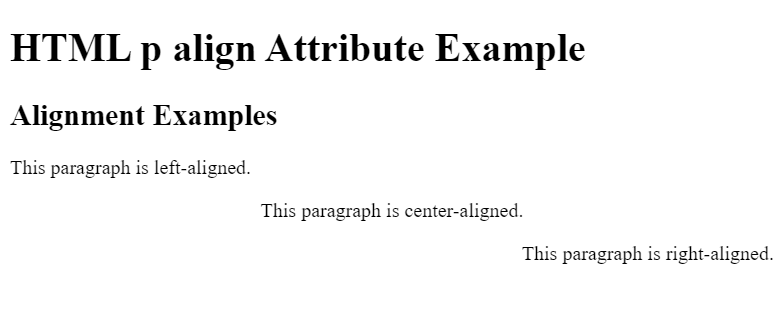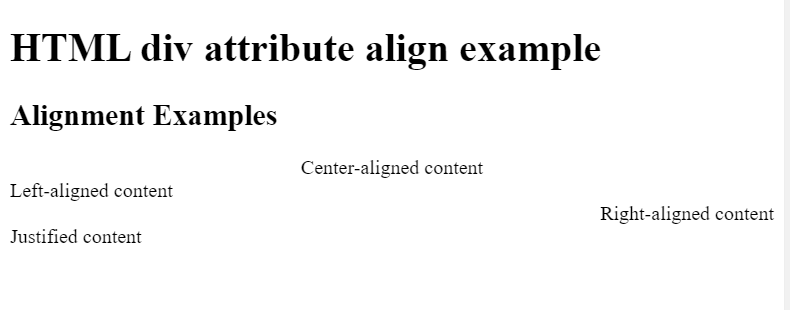HTML Align Tag
What is HTML?
Hypertext Markup Language, or HTML, is the common markup language used for web page creation and design. It defines a web page's fundamental organization and content, including headers, paragraphs, links, pictures, and lists. HTML marks up material with tags, where a tag in the document refers to a particular element or structure.
The Html gives an outline structure of the complete webpage. HTML pages are composed of nested components, each of which contains content or other elements. A simple HTML document, for example, may include an element that defines the document's metadata (title, character encoding, etc.) and an element with the page's primary content.
HTML Align Attribute:
In HTML, the alignment of the content within an element is specified using the `align` property. The align can be added with other elements, too. To align text within a paragraph, for example, put it in the '<p>' element. Nevertheless, it's crucial to remember that CSS should be used instead of the deprecated 'align' property in HTML5 for style and layout.
Supported Tags:
In HTML5, the align attribute, which was once used to align information inside different HTML elements, has been deprecated in favor of utilizing CSS for styling. For historical context, though, consider the following popular HTML components and the alignment choices that went along with them:
<p> (paragraph) Tag:
align="left": Aligns the content to the left.
align="center": Centers the content.
align="right": Aligns the content to the right.
align="justify": Justifies the content, creating even spacing between words.
<img> (image) tag:
align="left": Floats the image to the left, allowing text to wrap around it.
align="right": Floats the image to the right, allowing text to wrap around it.
<table> (table) tag:
align="left": Aligns the table to the left within its containing element.
align="center": Centers the table horizontally within its containing element.
align="right": Aligns the table to the right within its containing element.
<div> (division) tag:
align="left": Aligns the content inside the <div> to the left.
align="center": Centers the content inside the <div>.
align="right": Aligns the content inside the <div> to the right.
Attributes Values
In HTML, the values of the align property varied based on the element to which it was applied. The following are some typical attribute values and what they mean:
- Left: Moves the content inside its contained element to the left.
- Centre: Positions the content horizontally in the center of the element it contains.
- Right: Positions the content within its contained element to the right.
- Justify: Provides uniform word spacing while defending the content.
- Top: Centres the content (for tables and graphics) at the top of the element that contains it.
- Middle: (For photos and tables) Vertically centers the content within the enclosing element.
- Bottom: (For tables and pictures) Aligns the content to the bottom of the element it contains.
These attributes are used to align the property or place the element in different positions so that the alignment of the elements can be easily achieved.
Example 1:
<!DOCTYPE html>
<html>
<head>
<title>
HTML p align Attribute Example
</title>
</head>
<body>
<h1>HTML p align Attribute Example</h1>
<h2>Alignment Examples</h2>
<p align="left">
This paragraph is left-aligned.
</p>
<p align="center">
This paragraph is center-aligned.
</p>
<p align="right">
This paragraph is right-aligned.
</p>
</body>
</html>
Output
 <!DOCTYPE html>
<!DOCTYPE html><html>
<head>
<title>HTML div align Attribute Explication</title>
<style>
.center {
text-align: center;
}
.left {
text-align: left;
}
.right {
text-align: right;
}
.justify {
text-align: justify;
}
</style>
</head>
<body>
<h1>HTML div attribute align example </h1>
<h2>Alignment Examples</h2>
<div class="center">
Center-aligned content
</div>
<div class="left">
Left-aligned content
</div>
<div class="right">
Right-aligned content
</div>
<div class="justify">
Justified content
</div>
</body>
</html>
Output:
 Conclusion
Conclusion
In Conclusion, the `align` attribute is the one that was employed prior. The one that controls the content alignment within elements such as paragraphs (`<p>`), images (`<img>`), tables (`<table>`), and divisions (`<div>`). Yet, HTML5 has replaced the attribute with CSS for design and formatting. CSS has more control over alignment besides being able to manage the placement and positioning.
Therefore, it is used more in current web development projects. You can use CSS properties like `text-align` to align texts and use Flexbox or grid layout for more complex alignment issues. This strategy separates information from display, improving code readability and maintainability.